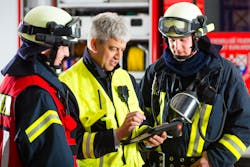Industry Insights: The Quest for Unattended Accountability
Editor's note: Industry Insights are sponsored blogs submitted by manufacturers and suppliers serving the fire service industry.
Ever since day one of my career bringing software solutions to the fire industry, I have consistently fielded requests for an unattended, or passive, accountability system.
Fire chiefs from across North America have told me that they want an accountability system that can track a firefighter from the moment they board the truck, until the moment they arrive back at the station, and every moment in between. On top of that, they want this to happen automatically.
Additionally, this desire is not unique to a specific type of department. Smaller rural departments want this functionality because they are strapped for personnel, and they don’t have the resources to allocate a person to solely operate an accountability system. Conversely, larger metropolitan departments want this functionality because they often have many personnel to account for, and the task can become overwhelming.
Conceptually, the idea of a purely automated accountability system sounds fantastic. A system that accounts for all of my firefighters, while freeing personnel up to attend to other tasks makes a lot of sense. Still, in practice, a system such as this may present some shortcomings.
The evolving technology
The good news is, as technology continues to progress, we have been able to convert many of these desires into reality. Through the use of RFID, near field communication, GPS, and more, systems are now able to automate accountability processes that used to be achieved through hanging a manual tag on a board, or scanning a barcode if you were using a more advanced system. This progression of technology provides departments with the power to track which firefighters are on scene, without the firefighter actually having to do anything other than board the truck and show up. Additionally, systems can automatically provide additional data, such as SCBA telemetry for air management and communication, providing significant automation in hot zone accountability.
However, much of this technology is evolving, and there are still gaps that remain in being able to automatically account for additional details such as functional assignment and firefighter location, which are more often than not included in the list of desired functionality of such a system.
All of this being said, key fundamentals of accountability require that the system be managed. For example, one of the most basic aspects of an accountability system, calling for PAR, and responding to this call, must be a manual process. Now, this is not to say that the call for PAR, and the response, can’t be an electronic function. In fact, this is highly desirable as it can speed the entire process, free up radio traffic, and improve firefighter safety. It’s simply stating that the response to a call for PAR must fall onto the shoulders of the firefighter to take action to respond to that call. Therefore, an accountability system can’t be completely passive in order to properly do its job.
It is reasonable to assume that, as time goes by, more automation will be brought to the fire service. The goals of these advancements is to bring an increase in safety and efficiency. Certainly, firefighter accountability is an area that can be improved with an increase in automation. However, due to the critical nature of accounting for your firefighters, and the required communication and scene management that must take place, the concept of a purely unattended accountability system is highly unlikely.
Adam Fray has been evaluating and implementing technology solutions for the fire service since 2011, and currently serves as the Field Marketing Manager for Software Solutions for Scott Safety. Adam holds a bachelor’s degree from Northern Michigan University and a masters from Davenport University. Adam has supported and led accountability and incident command operations at events throughout the country.
